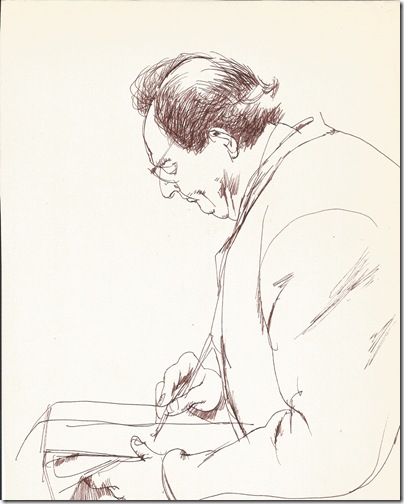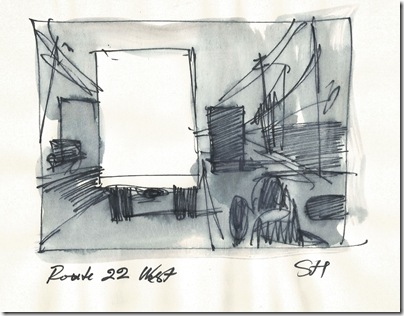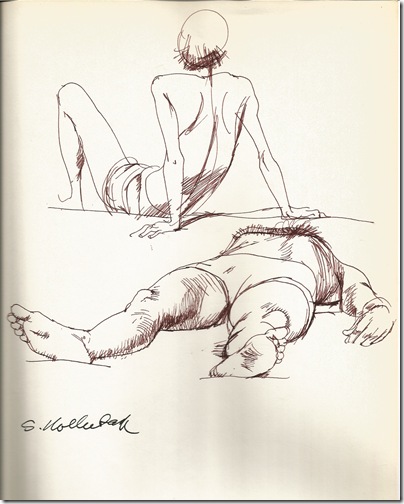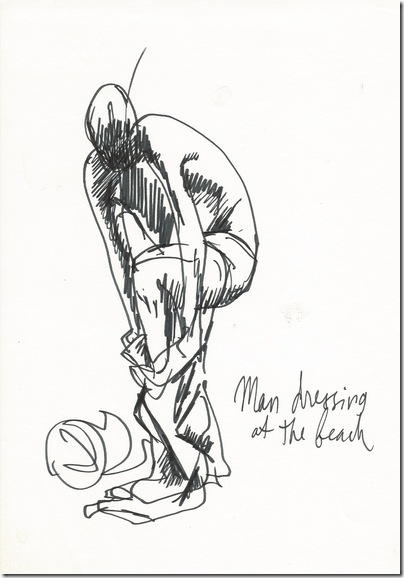
🗓️Friday, October 26, 2012
6:30 – 10:00 PM
FRANTS GALLERY SPACE NY
📍81 Wooster St, 4th fl, New York, NY 10012 USA
RSVP 📞212 343 0104
or 📧 anna@frantsgallery.com
The opening reception for
◆Eye of the Beholder◆
A selection of works by Serge Hollerbach
“I am I and my circumstance”
Jose Ortega y Gasset
Meditations on Quixote
1914
On the cover of the collected essays by Sergey Lvovich Hollerbach “Notes of an Artist”(1), there is one of his drawings included in the exhibition. The depicted person looks a little bit like the author, but Sergey Lvovich maintains that the drawing was not conceived as a self-portrait, even though one could not deny the resemblance of certain traits. This, so to speak, is a generalized image of an artist. He is depicted in profile with a sketchbook and a pen in hand, and he seems unaware that he is caught by a beholder, being fully engaged in his work.
The state of the moment and its essence are captured with such a precision that, for the effect of immediacy and laconism of visual means together with the virtuoso lightness of drawing, one does not grasp an existential depth of the generalization right away. This is how the artist (both the depicter and the depicted) stopped the moment. This effect is present in the entire creative work of S.L. Hollerbach. This moment need not necessarily be beautiful in the Faustian sense; it could be absolutely any moment, much like, admittedly, any place. The observation of real life in the frame of reference of time and place is, in my view, what constitutes the philosophy of Hollerbach-the-artist and Hollerbach-the-writer.
The duality of the visual at and the art of words (in particular, his essays and memoirs) is the key to understanding the creative persona of Sergey Lvovich.
Having decided to become an artist when he was just a teenager, he began studying drawing while he was still in Russia, in 1941. From that time on and until today, he has been interpreting the laws of development of art and the cause-and-effect relationship in the change of art styles and art movements, and this finds an expression in his creative work as an artist. At the same time, in parallel, he went to the trouble of writing down his meditations and observations that ultimately took the form of books that were literally written by an eyewitness of several epochs. These books, that have become bibliographic rarities, are sometimes accompanied by the author’s drawings that do not illustrate the text, but rather echo it.
Sergey Lvovich Hollerbach was born in 1923 in Tsarskoye Selo (at that time it was called Detskoye Selo, and later the town of Pushkin) in a vicinity of St. Petersburg. Erich Hollerbach, famous art historian of the Silver Age, was his uncle on his father’s side.
Brought up from the early age in the atmosphere of St. Petersburg’s culture (Westernizing as opposed to Slavophil) and aesthetic principles of the World of Art, Sergey Hollerbach began studying drawing when he was still a teenager. In 1941, he was admitted the famous Secondary Art School at the Art Academy in Leningrad. But he only got to study there for five months. The war began and, after the town of Pushkin was surrounded by German troops, he was taken to Germany. He described the ensuing ups and downs of his life in the memoirs (in Russian), part of which has already been published. Having made it through horrors of the war, including numerous air raids, and having survived by a miracle, he ultimately found himself in Munich by force of circumstances. There, in 1946, he became a student of the Famous Munich Art Academy where Russian artists had studied since the 19th century. Since Munich was at the time in the zone of American occupation, by a twist of fate, Hollerbach got an opportunity to go to America. So, in 1949, he got an American visa and moved to New York where he has lived ever since.
In New York, he ended up in the environment of representatives of the first wave of the immigration, which was so fertile in genius. He told about meeting many of them in his series of essays assembled under the same title New York Notebook; some of them were published in several issues of Noviy Zhurnal (The New Review) for 2011-2012. Currently, he prepares a separate publication. He speaks well about many and, in particular, his close friends – the sculptor Deryuzhinsky and the artists Rozhankovsky and Mstislav Dobuzhinsky; he knew the latter back in St. Petersburg.
Having been born in Russia, lived and studied in Europe, spent a greater part of his life in America, fluent in Russian, German and English, he, as he often likes to repeat, lives a triple life while never losing his sense of humor. He is a Russian Westernizer or, to be more precise, a man of the world. Formally, he is an American artist of Russian origins, but he considers himself a Russian artist.
Today, he is a full member of the American National Art Academy, an honorary president of the American Society of Watercolor Artists and a professor of painting.
Drawing and watercolors shown at this exhibition were made in the period from 1970s to 1990s in America. Their structure and plasticity are recognizable and characteristic of Sergey Lvovich. And his subjects are mostly people who never pose for him and who are devoid of pathos; they are engaged in the things they do, their relationships and thoughts. This is simultaneously the world, in which we live, and the world created by the artist.
The only painting included in the exhibition is Shoppers that was fortunately done in the fast-drying acrylic paints. It was finished in October of this year, that is to say, virtually two weeks before the opening night!
On November 1, Sergey Lvovich Hollerbach will turn 89. Let his open-mindedness, inner freedom and creative potential be our inspiration in the trying moments! We want to wish Sergey Lvovich creative success and many happy returns of the day. And to tell him a great big thank-you for his unique ability to convey the spirit of time and place, no matter when or where he is.
Natalia Krivinskaya.
October 16, 2012.
New York.
(1) Serge Hollerbach: Notes of an Artist. First Russian edition published in 1983 by Overseas Publications Interchange LTD, London


